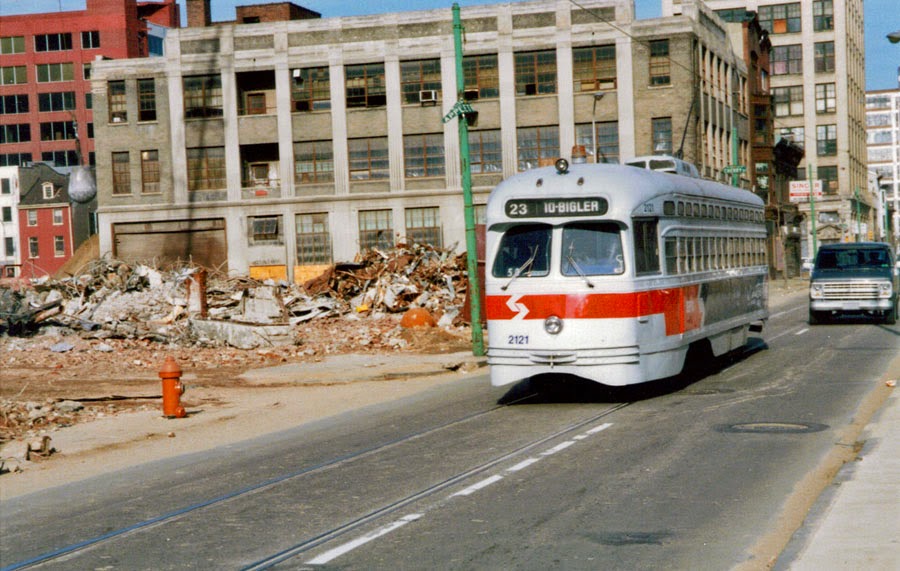For decades Philadelphia hosted two of the nation’s most notorious red light districts. Bound by North Broad Street, Market East, Chinatown, and including a wide and industrial stretch of Vine Street prior to the construction of the chasm that now segregates Center City from Callowhill, the Furnished Room District surrounding Reading Terminal and the Tenderloin to the north made up a den of iniquity so lewd that sailors docked in Philadelphia were forbidden from walking its streets.This post-industrial fallout of large warehouses and rundown hotels used as flophouses housed the city’s homeless, drug addicts, and prostitutes. Chinatown hosted the city’s opium dens and burlesque houses, including The Trocadero, and its eccentric inhabitants called the Furnished Room District and Tenderloin their home.

View of the Furnished Room District and Reading Terminal from atop City Hall
The Furnished Room District's sex themed history spanned a century, with two adult bookstores still occupying the corner of 13th and Arch until the last decade. While the last sordid businesses lingered into the 21st Century, city planners began chipping away at this neighborhood’s infrastructure in the 80’s and 90’s.

12th and Arch in 1917
Following The Gallery, the relocation of Reading Terminal’s trains to a new Market East Station required the demolition of several blocks of Chinatown to accommodate underground rail tunnels. While moving the trains underground eliminated the need for the noisy elevated Reading Viaduct, it left Chinatown scarred with a number of large surface parking lots.

1311 Filbert - 1911
During this transition phase, the Furnished Room District became a refuge for Bohemia. Artists and punks occupied the apartments above the remaining storefronts. Nightlife in the district was limited to several small bars including Pentony Tavern which was a gay bar on Filbert Street, several adult themed bookstores, and rampant prostitution. David Lynch lived in the Tenderloin at 13th and Wood in the early 1970's and wrote of it, "Philadelphia, more than any filmmaker, influenced me. It's the sickest, most corrupt, decaying, fear-ridden city imaginable. I was very poor and living in bad areas. I felt like I was constantly in danger. But it was so fantastic at the same time."

Breintnall Building's Adult Entertainment Center in the 1990s
The Vine Street Expressway drove a wedge between the district’s hotels and residences and The Tenderloin to the north. It called for the demolition of almost every building on the south side of Vine Street, leaving a street scape lined with narrow parking lots.
While transportation improvements left the Furnished Room District and Chinatown to suffer, the blocks behind Reading Terminal were chosen for the Pennsylvania Convention Center, requiring an expansive clearing of the district’s original architecture. At the same time, politicians were eying Chinatown’s northern annex as the location for a new baseball stadium and had planned to run an expressway exit right through its heart.

Chinatown's Trocadero in 1978
These two proposals were successfully blocked by neighborhood opposition but by then Chinatown had been boxed in by several large civic developments: the Convention Center, The Gallery and bus terminal, The Vine Street Expressway, and a sea of surface parking lots west of Franklin Square.

Near 12th and Race - Demolition for the first phase of the Pennsylvania Convention Center
The final phase of the Convention Center, currently under construction, cleared most of the remaining architecturally significant and historic representations of the Furnished Room District’s eclectic buildings including the Race Street Firehouse, The Lithograph Building, the Metzger Building, and a number of others.
Today, very little remains of this once infamous neighborhood. By targeting blight and ignoring architectural significance, developers have managed to completely erase an entire neighborhood and thus, its history. A small strip of industrial buildings have been restored along the 1200 block of Arch Street and a handful of industrial and small row houses are still maintained on and above Race between 11th and Broad.

12th and Arch in the 1970s
A portion of the original Tenderloin lives on as Callowhill and Chinatown’s northern annex, sometimes called the Loft District, or Eraserhead by cinema buffs who pay homage to the inspiration of David Lynch's movie of the same name, inspiration that is now a U-Haul parking lot. Meanwhile in the former Furnished Room District, very little movement has been made to develop what remains. Aside from the Convention Center, the district now mostly consists of poorly maintained surface parking lots.
Such projects often attract chain restaurants and retail establishments that cater to tourists and conventioneers and one can hope that it will attract these businesses to the area’s arterial streets such as North Broad and Market East. Unfortunately the Convention Center’s north side pays no respect to what remains of its original architecture. With a wide overhang supporting a garage used to park utility vehicles, its narrow sidewalk devoid of trees; it doesn’t encourage the kind of growth that surrounds most American convention spaces. It remains to be seen if the Convention Center will attract the kind of business the state once promised.





















